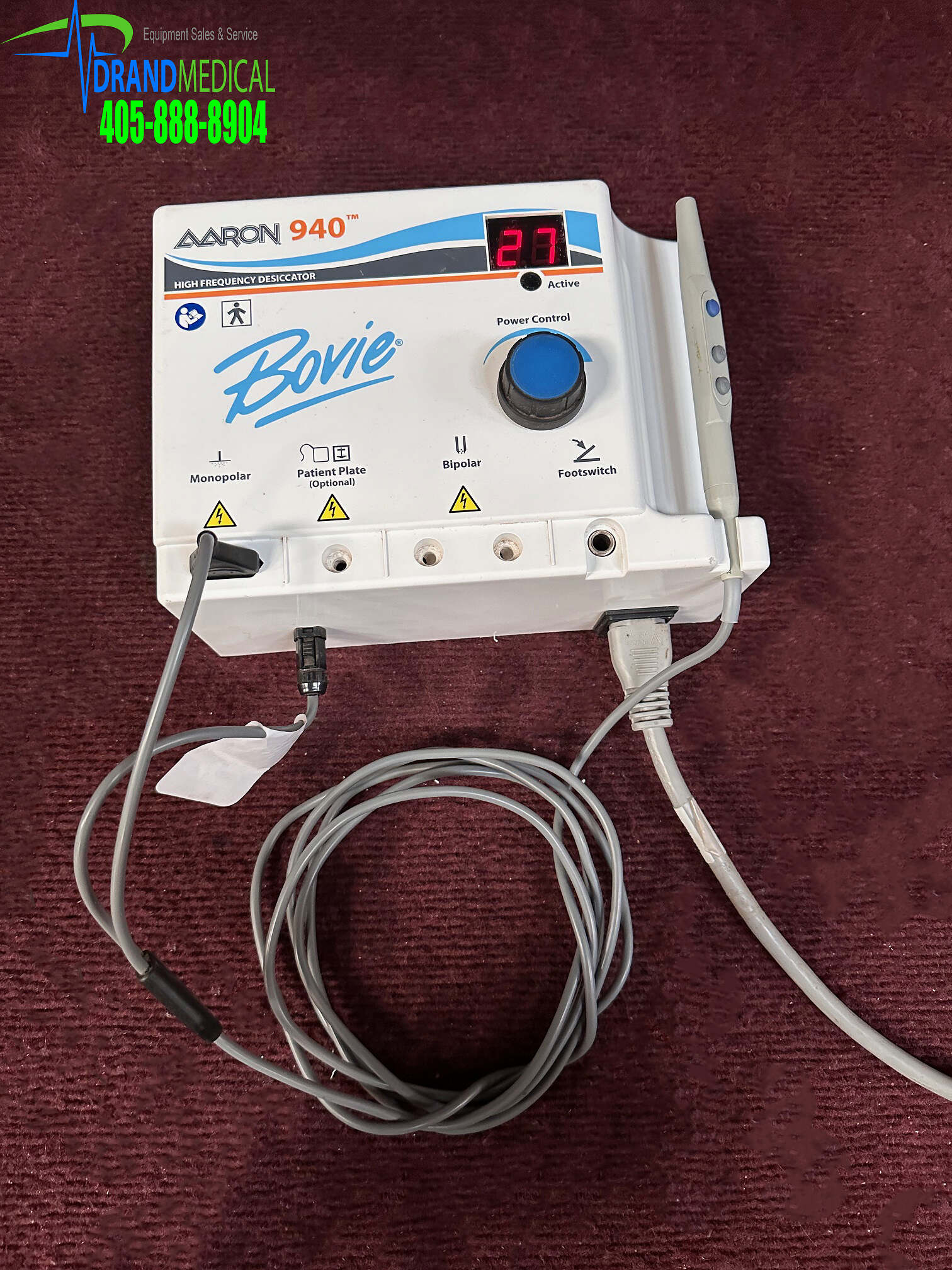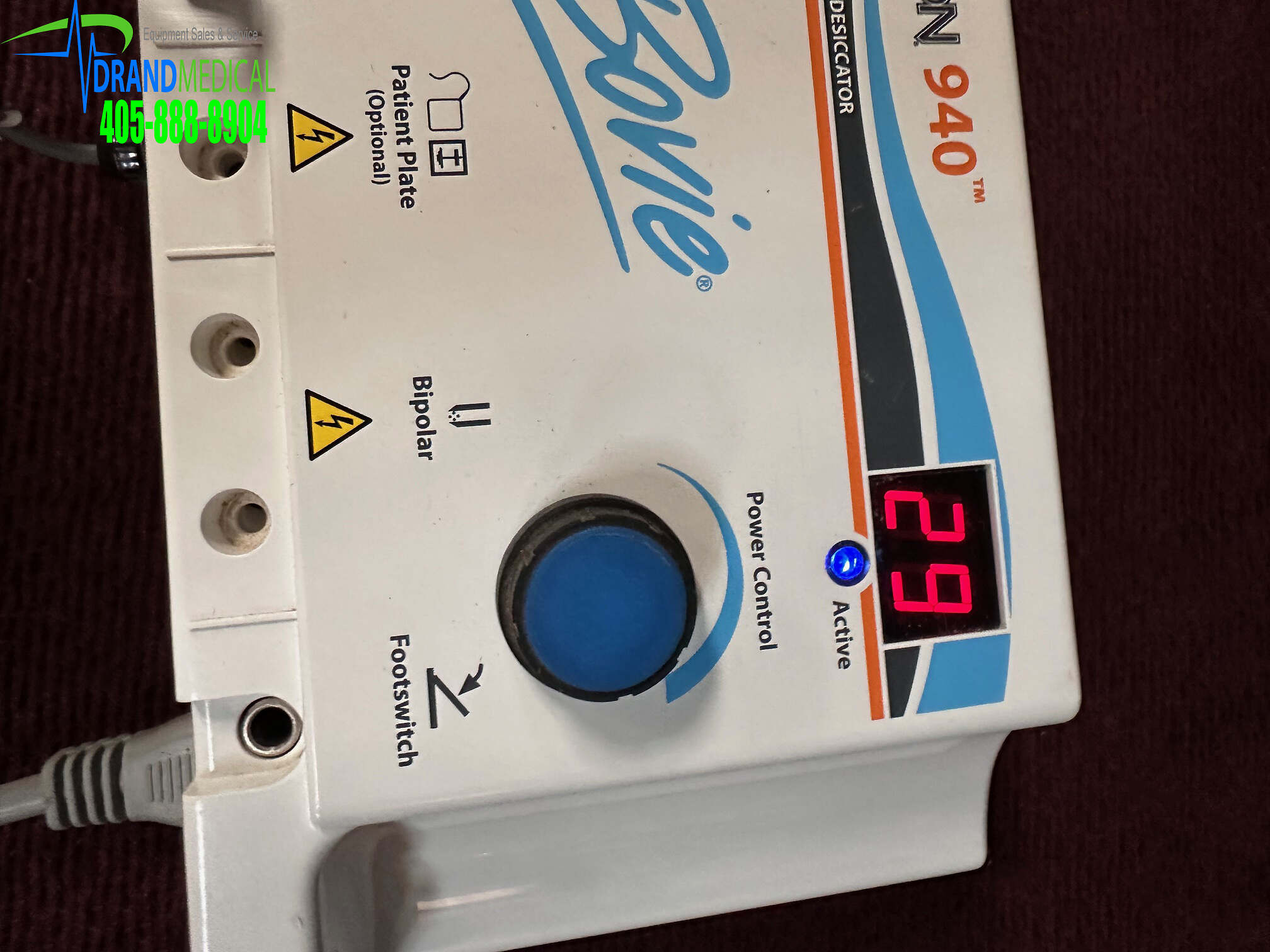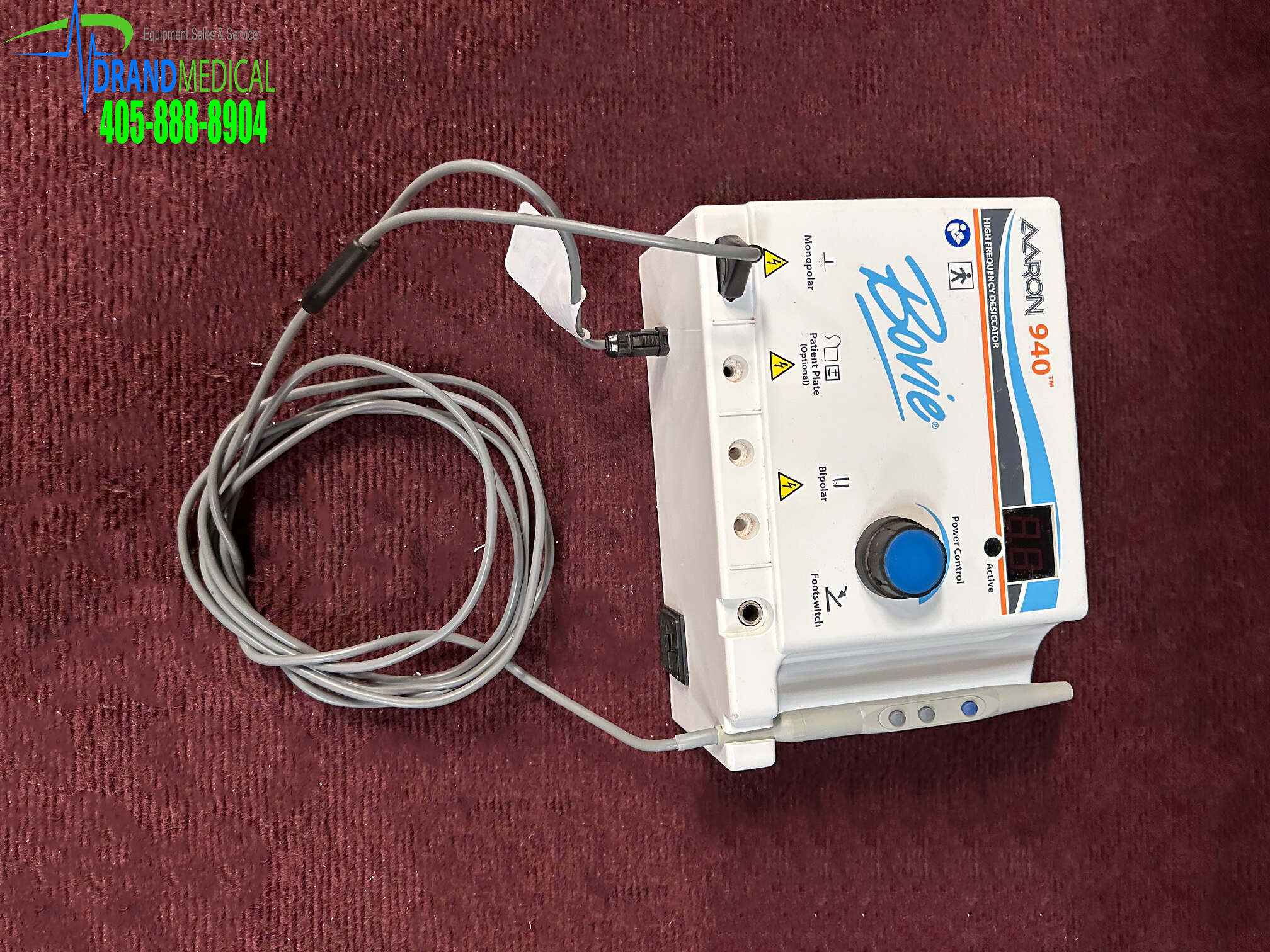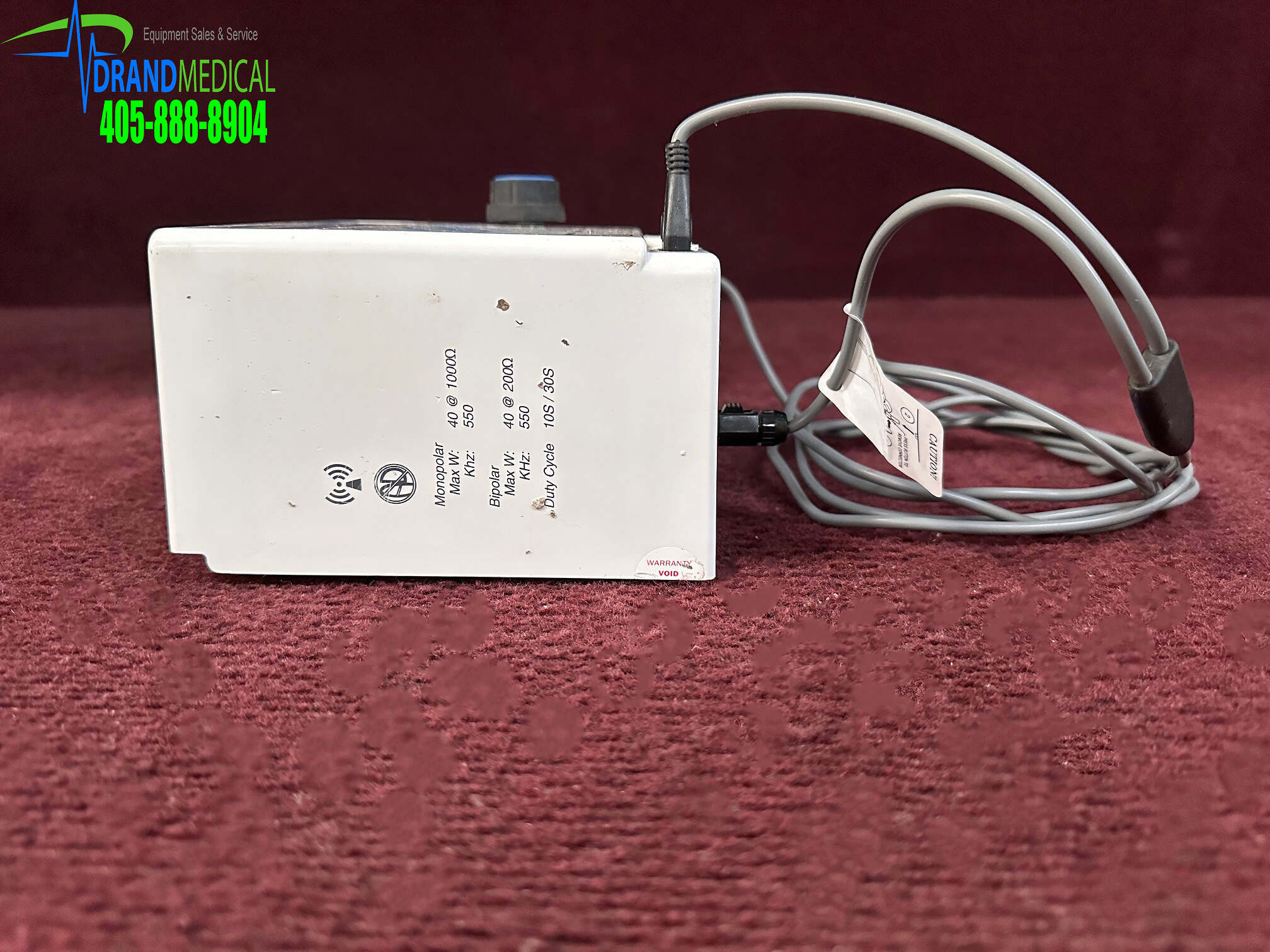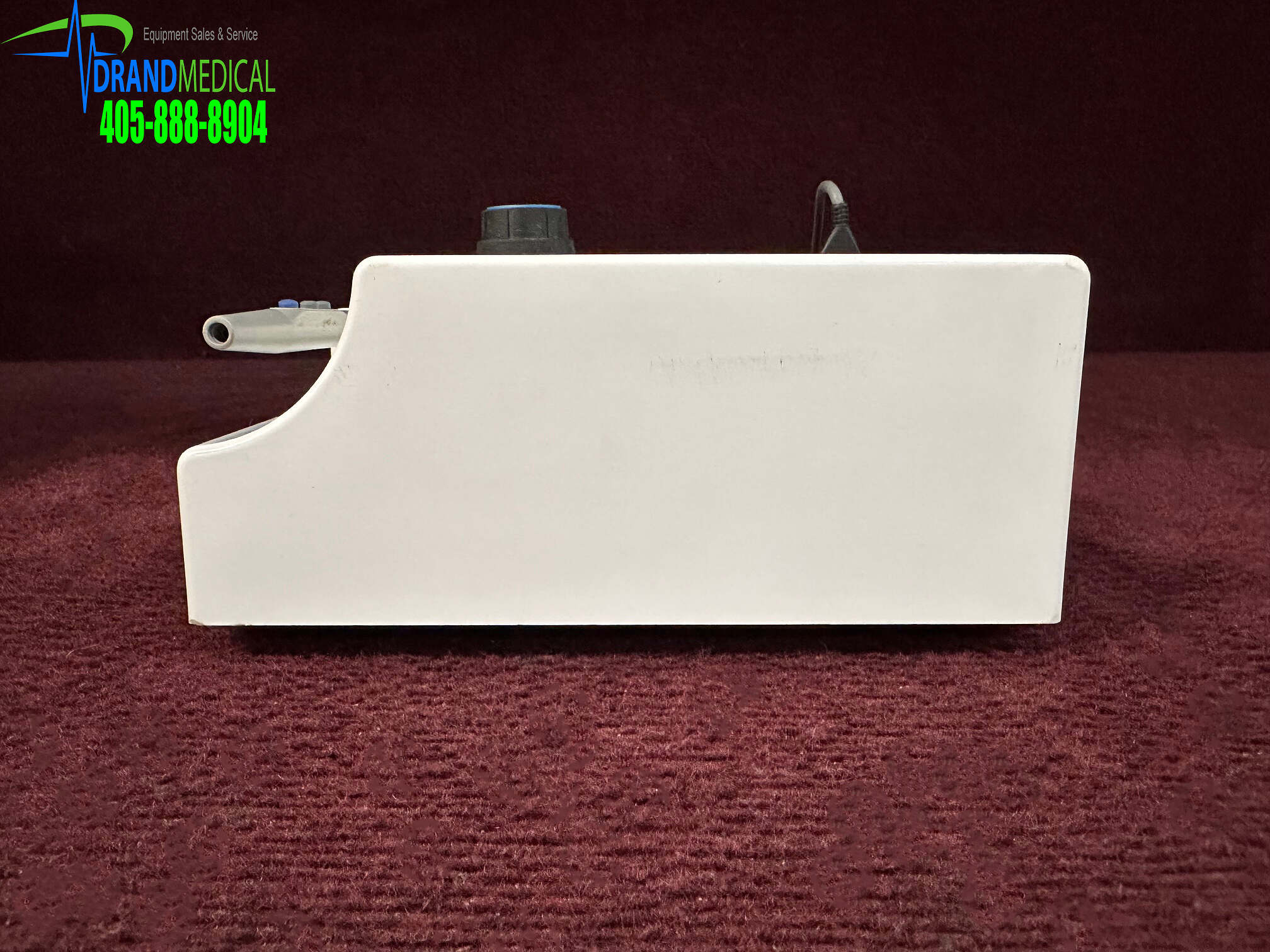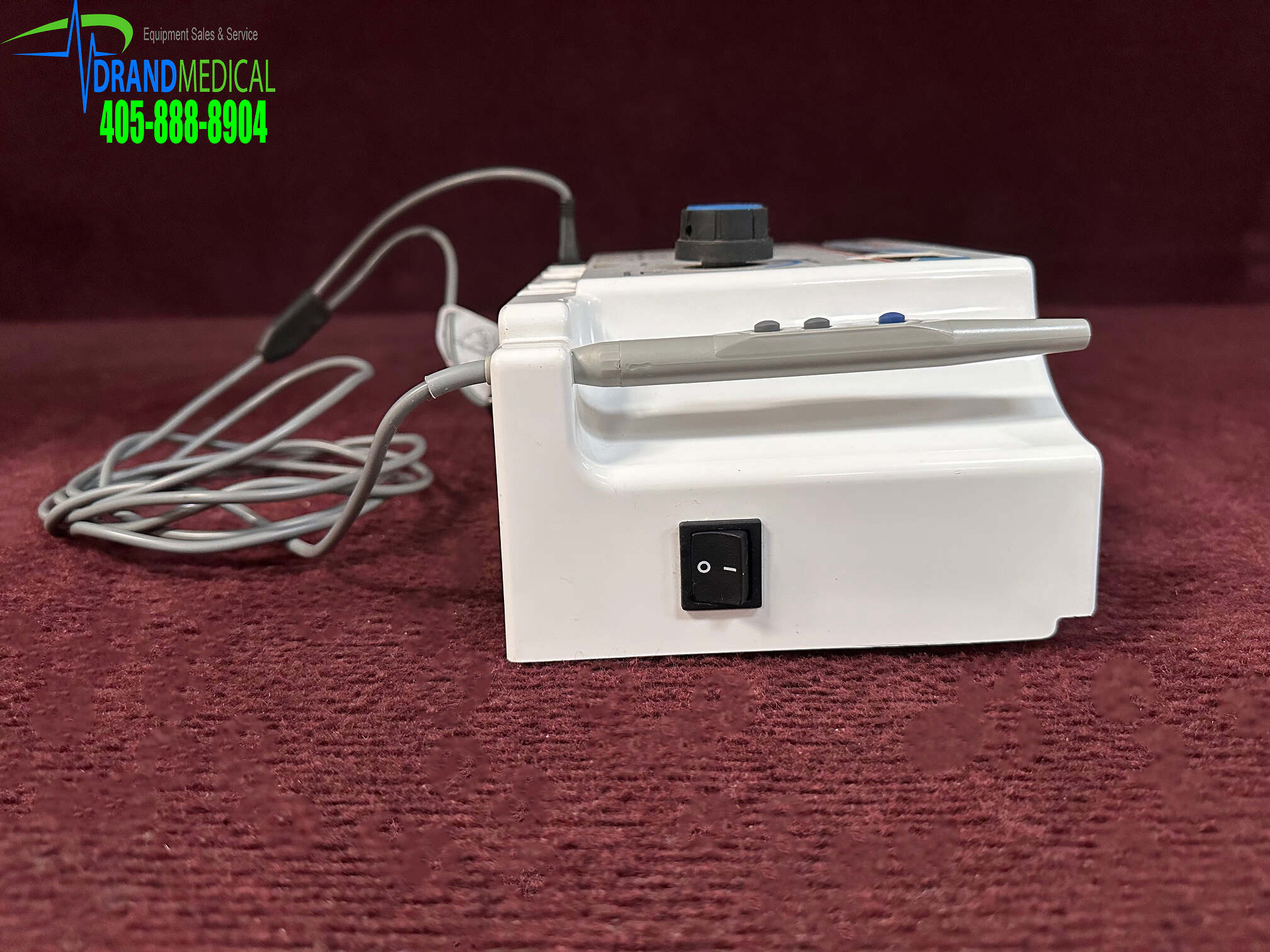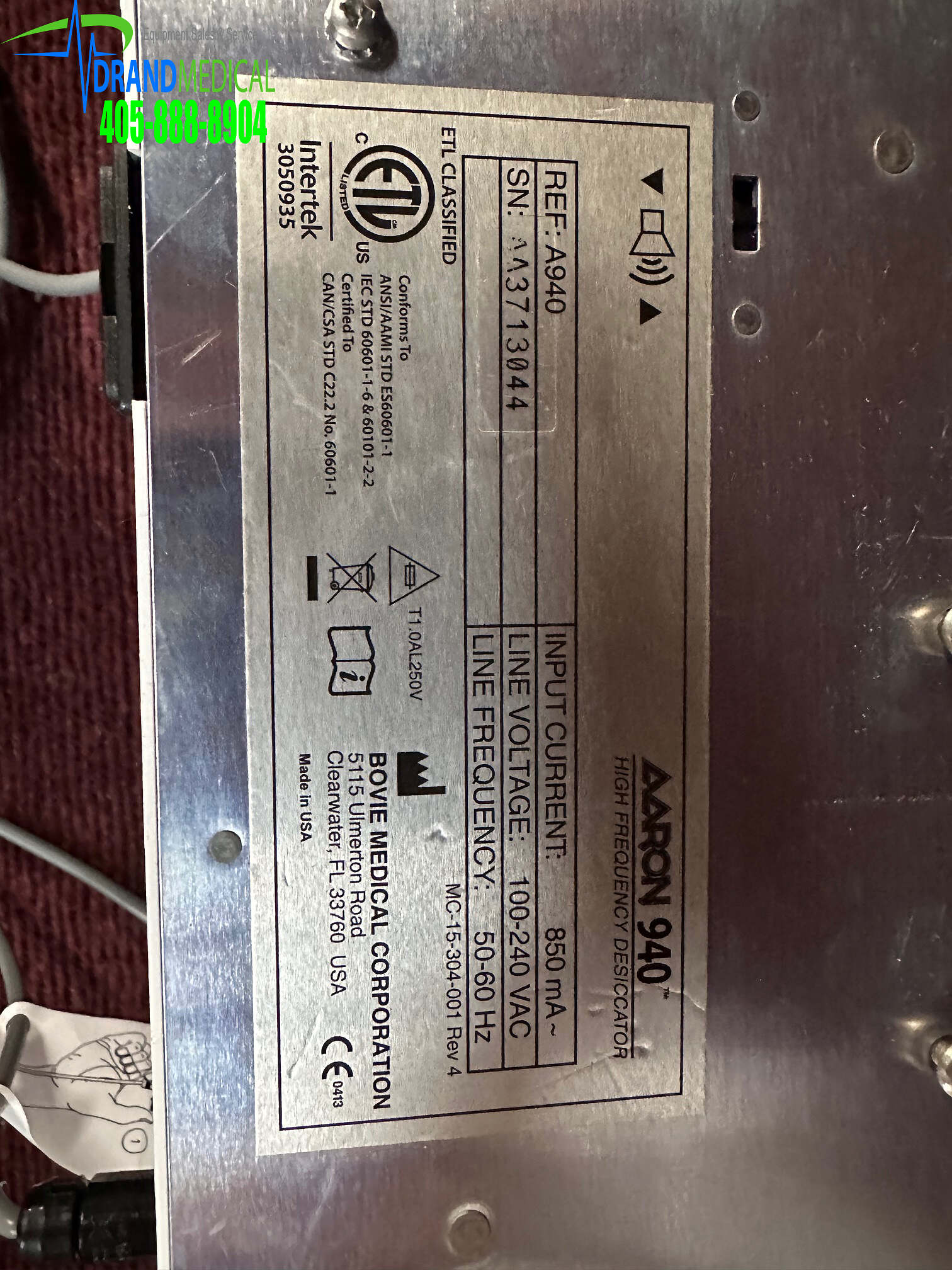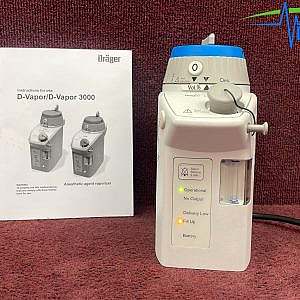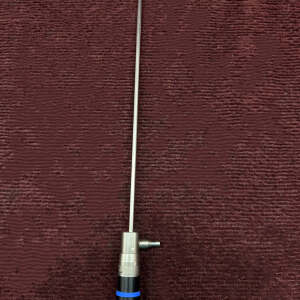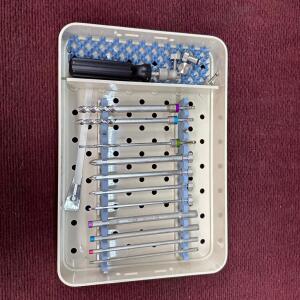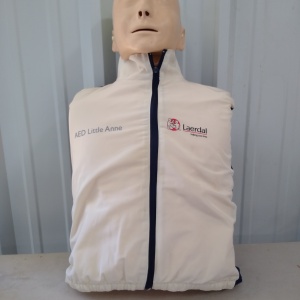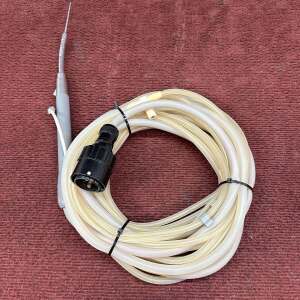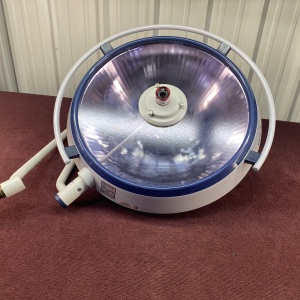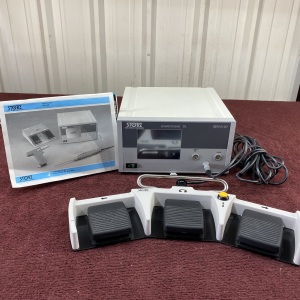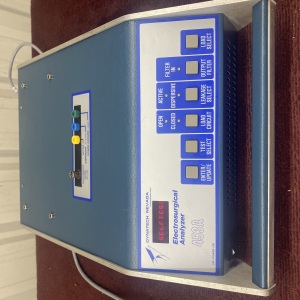Description
The Aaron 940 High Frequency Desiccator.
The Aaron 940™ produces radio frequency current which is useful for the removal and destruction of superficial cutaneous and mucosal lesions. This is done by performing desiccation and fulguration procedures. Electrosurgical desiccation occurs when the electrode is placed directly onto the surface of the lesion. Fulguration occurs when the electrode is held slightly above the lesion and an arc is delivered to the lesion. The unit also provides fast and efficient bleeding control by coagulation of capillaries and small blood vessels.
For the majority of desiccation, fulguration, and coagulation procedures utilizing the standard handpiece in the monopolar output, the patient plate is optional. When used, the patient plate will intensify the coagulation properties of the unit and also lessen the opportunity for an electrosurgical burn. The optional footswitch adds versatility when using the standard handpiece in the monopolar output, as the footswitch allows you to activate the unit by either the handpiece or the footswitch. Bipolar outputs are available for those physicians who prefer to utilize bipolar forceps to perform coagulation procedures. A footswitch is required when using the bipolar output and the patient plate is not used. Procedures that are performed in sensitive areas may require an anesthetic. Flammable anesthetics should not be used.
If you are unfamiliar with the operation of a low powered electrosurgery unit, it is advisable to practice on chicken or lean flank steak to visualize the effects at various output and power levels.
WARNINGS AND CAUTIONS
In order to safely operate the Aaron 940™, several precautions need to be followed.
|
WARNINGS:
|
|
Hazardous Electrical Output – This equipment is for use only by trained, licensed physicians.
|
|
Danger: Fire / Explosion Hazard – Do not use the Aaron 940™ in the presence of flammable materials.
|
|
Fire / Explosion Hazard – The following substances will contribute to increased fire and explosion hazards in the operating room:
-
Flammable substances (such as alcohol based skin prepping agents and tinctures)
-
Naturally occurring flammable gases which may accumulate in body cavities such as the bowel
-
Oxygen enriched atmospheres
-
Oxidizing agents (such as nitrous oxide [N20] atmospheres).
The sparking and heating associated with electrosurgery can provide an ignition source. Observe fire precautions at all times. When using electrosurgery in the same room with any of these substances or gases, prevent their accumulation or pooling under surgical drapes, or within the area where electrosurgery is performed.
|
|
To avoid risk of electric shock, this equipment must only be connected to a supply mains with protective earth.
|
|
Connect the power cord to a properly polarized and grounded power source with the frequency and voltage characteristics that match those listed on the back of the unit.
|
|
Electric Shock Hazard – Connect the generator power cord to a properly grounded receptacle. Do not use power plug adapters.
|
|
Electric Shock Hazard – Always turn off and unplug the generator before cleaning.
|
|
Fire Hazard – Do not use extension cords.
|
|
No modification of this equipment is allowed.
|
|
Patient Safety – Use the generator following the directions described in the Setup Procedures. Otherwise, inaccurate power outputs may result.
|
|
Failure of the high frequency electrosurgical equipment could result in an unintended increase of output power.
|
|
The instrument receptacles on this generator are designed to accept only one instrument at a time. Do not attempt to connect more than one instrument at a time into a given receptacle. Doing so will cause simultaneous activation of the instruments.
|
|
Use the lowest output setting necessary to achieve the desired surgical effect. Use the active electrode only for the minimum time necessary in order to lessen the possibility of unintended burn injury. Pediatric applications and/or procedures performed on small anatomic structures may require reduced power settings. The higher the current flow, and the longer the current is applied, the greater the possibility of unintended thermal damage to tissue, especially during use on small structures.
|
|
Use electrosurgery with caution in the presence of internal or external devices such as pacemakers or pulse generators. Interference produced by the use of electrosurgical devices can cause devices such as pacemakers to enter an asynchronous mode or can block the pacemaker effect entirely. Consult the device manufacturer or hospital Cardiology Department for further information when use of electrosurgical appliances is planned for patients with cardiac pacemakers or other implantable devices.
|
|
If the patient has an Implantable Cardioverter Defibrillator (ICD), contact the ICD manufacturer for instructions before performing an electrosurgical procedure. Electrosurgery may cause multiple activation of ICDs.
|
|
Do not use electrosurgical equipment unless properly trained to use it in the specific procedure being undertaken. Use by physicians without such training has resulted in serious, unintended patient injury, including bowel perforation and unintended, irreversible tissue necrosis.
|
|
For surgical procedures where the high frequency current could flow through parts of the body having a relatively small cross-sectional area, the use of bipolar techniques may be desirable to avoid unwanted coagulation.
|
|
For all Monopolar modes, any associated equipment and active electrodes must be rated to with stand the combination of output voltage, vp-p and crest factor as stated in this manual.
|
|
In some circumstances, potential exists for alternate site burns at points of skin contact (e.g., between the arm and the side of the body). This occurs when electrosurgical current seeks a path to the return electrode that includes the skin-to-skin contact point. Current passing through small skin-to-skin contact points is concentrated and may cause a burn. This is true for grounded, ground referenced, and isolated output generators.
|
|
To reduce the potential for alternate site burns, do one or more of the following:
-
Avoid skin-to-skin contact points, such as fingers touching leg, when positioning the patient.
-
Place 5 to 8 cm (2 to 3 in.) of dry gauze between contact points to ensure that contact does not occur
-
Position the return electrode to provide a direct current route between the surgical site and the return electrode which avoids skin-to-skin contact areas.
-
In addition, place patient return electrodes according to the manufacturer’s instructions.
Potential for alternate site burns increases if the return electrode is compromised. Bovie recommends the use of split return electrodes and Bovie generators with a contact quality monitoring system.
|
|
Minor neuromuscular stimulation is possible when arcs between the ACTIVE ELECTRODE and tissue occur. The generator has been designed to minimize the possibility of neuromuscular stimulation.
|
|
The entire area of the neutral electrode should be reliably attached to the patient’s body and as close to the operating field as possible.
|
|
The cables to surgical electrodes should be positioned in such a way that contact with the patient or other leads is avoided. Temporarily unused active electrodes should be stored so that they are isolated from the patient.
|
|
Do not wrap the accessory cords or return electrode cords around metal objects. This may induce currents that could lead to shocks, fires, or injury to the patient or surgical team.
|
|
The use of flammable anesthetics or oxidizing gases such as nitrous oxide (N2O) and oxygen should be avoided if a surgical procedure is carried out in the region of the thorax or the head, unless these agents are sucked away.
|
|
Non-flammable agents should be used for cleaning and disinfection wherever possible. Flammable agents used for cleaning or disinfecting, or as solvents of adhesives, should be allowed to evaporate before the application if HF surgery. There is a risk of pooling flammable solutions under the patient or in body depressions such as the umbilicus, and in body cavities such as the vagina. Any fluids pooled in these areas should be mopped up before HF surgical equipment is used. Attention should be called to the danger of ignition of endogenous gases. Some materials, for example cotton, wool and gauze, when saturated with oxygen may be ignited by sparks produced in Normal Use of the HF surgical equipment.
|
|
CAUTIONS:
|
|
At no time should you touch the active electrode or bipolar forceps. A burn could result.
|
|
Do not stack equipment on top of the generator or place the generator on top of electrical equipment. These configurations are unstable and/or do not allow adequate cooling.
|
|
Provide as much distance as possible between the electrosurgical generator and other electronic equipment (such as monitors). An activated electrosurgical generator may cause interference with them.
|
|
Non-function of the generator may cause interruption of surgery. A backup generator should be available for use.
|
|
Do not turn the activation tone down to an inaudible level. The activation tone alerts the surgical team when an accessory is active.
|
|
When using a smoke evacuator in conjunction with the electrosurgical generator, place the smoke evacuator a distance from the generator and set the generator volume control at a level that ensures that the activation tones can be heard.
|
|
The use of high frequency current can interfere with the function of other electromagnetic equipment.
|
|
When high frequency surgical equipment and physiological monitoring equipment are used simultaneously on the same patient, place any monitoring electrodes as far as possible from the surgical electrodes. Monitoring systems incorporating high frequency current-limiting devices are recommended.
|
|
Do not use needles as monitoring electrodes during electrosurgical procedures. Inadvertent electrosurgical burns may result.
|
|
To avoid the possibility of an electrosurgical burn to either the patient or the physicians, do not allow the patient to come in contact with a grounded metal object during activation. When activating the unit, do not allow direct skin contact between the patient and the physician.
|
|
The patient should not come in contact with metal parts which are earthed or which have an appreciable capacitance to earth (for example operating table supports, etc.). The use of antistatic sheeting is recommended for this purpose.
|
|
Remove any loose fitting jewelry from the patient before activation.
|
|
Examine all accessories and connections to the electrosurgical generator before use. Ensure that the accessories function as intended. Improper connection may result in arcs, sparks, accessory malfunction, or unintended surgical effects.
|
|
Accessories must be connected to the proper receptacle type. In particular, bipolar accessories must be connected to the Bipolar Instrument output jack only. Improper connection may result in inadvertent generator activation.
|
|
When not using active accessories, place them in a holster or in a clean, dry, non-conductive, and highly visible area not in contact with the patient. Inadvertent contact with the patient may result in burns.
|
|
Avoid HF output settings where maximum output voltage may exceed rated accessory voltage. Refer to the accessory’s voltage rating.
|
|
To avoid incompatibility and unsafe operation, use suitable cables, accessories, active and neutral electrodes, including values for the highest allowed H.F. peak voltage.
|
|
The output power selected should be as low as possible for the intended purpose. Certain devices or accessories may present a safety hazard at low power settings.
|
|
Apparent low output or failure of the Aaron 940™ to function correctly at the normal operating settings may indicate faulty application of the neutral electrode or poor contact in its connections. In this case, the application of the neutral electrode and its connections should be checked before selecting a higher output power.
|
|
When using Monopolar mode, associated equipment and active accessories should be selected that have a voltage rating of 8.0 kV pp or greater.
|
|
When using Bipolar mode, associated equipment and active accessories should be selected that have a voltage rating of 2.5 kV pp or greater.
|
|
Studies have shown that smoke generated during electrosurgical procedures can be potentially harmful to patients and the surgical team. These studies recommend adequately ventilating the smoke by using a surgical smoke evacuator or other means.
|
CONTRAINDICATIONS
There are no known contraindications.
NOTICES: If required by local codes, connect the generator to the hospital equalization connector with an equipotential cable. Do not clean the generator with abrasive cleaning or disinfectant compounds, solvents, or other materials that could scratch the panels or damage the generator.
APPLICATION SPECIFICATION
Description
-
A 40 Watt RF desiccator used to coagulate tissue using RF waveform.
-
Power setting is selectable by front panel manipulation of a rotary encoder knob.
-
Power and activation are indicated on the unit display.
Medical Purpose / Indication
Site Condition
Patient Population – * Patient should not be user.
Intended User Profile
-Minimum:
– Understands electrosurgery and electrosurgical techniques;
– Read and understands supplied User’s Guide (Accompanying Document)
– Understands hygiene
– Maximum:
– There is no maximum
– Minimum:
– Some training on techniques or training under surveillance/supervision
– No special experience needed
– Maximum:
– There is no maximum
– Permissible Impairments:
– Mild reading / vision impairment or vision correction to 20/20
– Partial hearing impairment, allowing for audible detection of tones at 0.5-2.0 kHz.
Ready to ship in 1-3 business days
from United States (US)
Shipping Policy
All of our products are professionally packaged to assure your items arrive safely.
